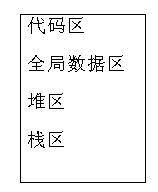C++的static有两种用法:面向过程程序设计中的static和面向对象程序设计中的static。前者应用于普通变量和函数,不涉及类;后者主要说明static在类中的作用。
?
?
?
一、面向过程设计中的static
?
1、静态全局变量
?
在全局变量前,加上关键字static,该变量就被定义成为一个静态全局变量。我们先举一个静态全局变量的例子,如下:
?
//Example 1
#include <iostream.h>
void fn();
static int n; //定义静态全局变量
void main()
{
n=20;
cout<<n<<endl;
fn();
}
void fn()
{
n++;
cout<<n<<endl;
}
?
? ?静态全局变量有以下特点:
对于一个完整的程序,在内存中的分布情况如下图:
?

?
一般程序的由new产生的动态数据存放在堆区,函数内部的自动变量存放在栈区。自动变量一般会随着函数的退出而释放空间,静态数据(即使是函数内部的静态局部变量)也存放在全局数据区。全局数据区的数据并不会因为函数的退出而释放空间。
?
细心的读者可能会发现,将Example 1中的代码
?
static int n; //定义静态全局变量
??改为
?
int n; //定义全局变量?
程序照样正常运行。的确,定义全局变量就可以实现变量在文件中的共享,但定义静态全局变量还有以下好处:
你可以将上述示例代码改为如下:
?
//Example 2
//File1
#include <iostream.h>
void fn();
static int n; //定义静态全局变量
void main()
{
n=20;
cout<<n<<endl;
fn();
}
//File2
#include <iostream.h>
extern int n;
void fn()
{
n++;
cout<<n<<endl;
}
? ? 编译并运行Example 2,您就会发现上述代码可以分别通过编译,但运行时出现错误。试着将:
?
static int n; //定义静态全局变量
?
? ? 改为
?
int n; //定义全局变量
?
? ? 再次编译运行程序,细心体会全局变量和静态全局变量的区别。
?
? ? 注意事项:
?
?
2、静态局部变量
?
在局部变量前,加上关键字static,该变量就被定义成为一个静态局部变量。
?
我们先举一个静态局部变量的例子,如下:
//Example 3
#include <iostream.h>
void fn();
void main()
{
fn();
fn();
fn();
}
void fn()
{
static n=10;
cout<<n<<endl;
n++;
}
//Example 4
#include <iostream.h>
static void fn();//声明静态函数
void main()
{
fn();
}
void fn()//定义静态函数
{
int n=10;
cout<<n<<endl;
}
?
? ? 定义静态函数的好处:
//file1.cpp
static int varA;
int varB;
extern void funA()
{
...
}
static void funB()
{
...
}
//file2.cpp
extern int varB; // 使用file1.cpp中定义的全局变量
extern int varA; // 错误! varA是static类型, 无法在其他文件中使用
extern vod funA(); // 使用file1.cpp中定义的函数
extern void funB(); // 错误! 无法使用file1.cpp文件中static函数
?
//Example 5
#include <iostream.h>
class Myclass
{
public:
Myclass(int a,int b,int c);
void GetSum();
private:
int a,b,c;
static int Sum;//声明静态数据成员
};
int Myclass::Sum=0;//定义并初始化静态数据成员
Myclass::Myclass(int a,int b,int c)
{
this->a=a;
this->b=b;
this->c=c;
Sum+=a+b+c;
}
void Myclass::GetSum()
{
cout<<"Sum="<<Sum<<endl;
}
void main()
{
Myclass M(1,2,3);
M.GetSum();
Myclass N(4,5,6);
N.GetSum();
M.GetSum();
}
?
? ? 可以看出,静态数据成员有以下特点:
//Example 6
#include <iostream.h>
class Myclass
{
public:
Myclass(int a,int b,int c);
static void GetSum();/声明静态成员函数
private:
int a,b,c;
static int Sum;//声明静态数据成员
};
int Myclass::Sum=0;//定义并初始化静态数据成员
Myclass::Myclass(int a,int b,int c)
{
this->a=a;
this->b=b;
this->c=c;
Sum+=a+b+c; //非静态成员函数可以访问静态数据成员
}
void Myclass::GetSum() //静态成员函数的实现
{
// cout<<a<<endl; //错误代码,a是非静态数据成员
cout<<"Sum="<<Sum<<endl;
}
void main()
{
Myclass M(1,2,3);
M.GetSum();
Myclass N(4,5,6);
N.GetSum();
Myclass::GetSum();
}
?
? ? 关于静态成员函数,可以总结为以下几点: